What Is Psoriatic Arthritis?
Psoriatic arthritis (PsA), a type of spondyloarthritis, is a chronic, progressive inflammatory disease of the joints and fibrous entheses (regions where a tendon, ligament, or joint capsule gets attached to the bone).
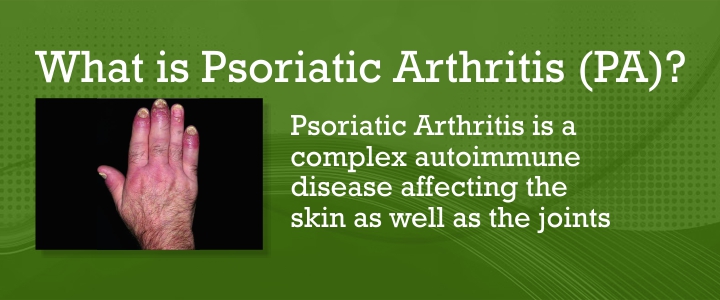
It usually affects people who are suffering from a skin condition called Psoriasis, which causes patches of red, raised skin with white and silvery flakes. About 30% of people with Psoriasis are affected by Psoriatic Arthritis.
Both, Psoriasis and Psoriatic arthritis are autoimmune conditions, wherein, the immune system becomes confused and attacks healthy parts of the body instead of protecting them against illness and infections. Both these conditions can affect people of any age group. The joints being the target of the immune attack, Psoriatic arthritis is characterized by swelling, pain, fatigue, and stiffness in the joints.
Sometimes, patients experience the signs and symptoms of arthritis before psoriasis. However, in rare instances, patients suffering from psoriatic arthritis may never get any noticeable spots of psoriasis. One in five individuals with psoriasis is reported to develop psoriatic arthritis.
It’s one of the most common types of arthritis, right after osteoarthritis and rheumatoid arthritis. Although all three types of arthritis have overlapping symptoms, one of the most distinguishing characteristics of psoriatic arthritis is that 85% of individuals living with this disease also have psoriasis.
Not only psoriatic arthritis affect men and women equally, but also its onset occurs in adults between the ages of 30 and 50 most often. Even though juvenile psoriatic arthritis can occur, it is far less common. Around 30% of individuals who experience psoriasis may also develop psoriatic arthritis, but not everyone.
Homeopathic Treatment For Psoriatic Arthritis
Psoriatic Arthritis is an autoimmune condition that occurs when your body attacks your healthy joints and causes inflammation. If untreated, Psoriatic Arthritis can cause permanent joint damage. Though there is no cure, there is a growing range of treatments available to help stop the disease progression, lessen pain, protect the joints, and preserve the range of motion.
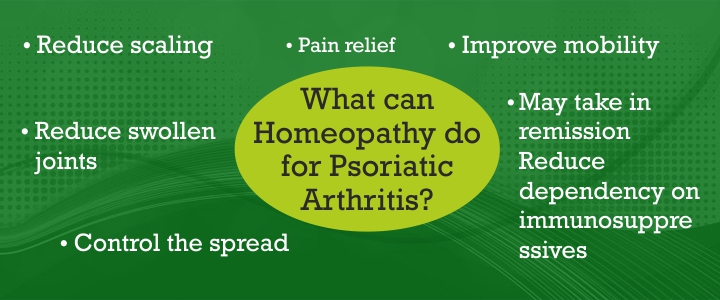
Scope Of Homeopathy
Disease course and prognosis vary from patient to patient and also depend on the form the disease takes. Also, the severity of the rash does not mirror the severity of arthritis, and the skin condition does not necessarily occur at the same time as arthritis.
As per our experience, we have observed:
- Mild and early cases, but not immune-compromised cases, have excellent chances of recovery.
- Moderate, severe, and 3-5-year-old cases, with less use of methotrexate or other immunosuppressive medicines, have good chances of recovery.
- Very severe, very old (> 8 years), multi-joint affection and cases with more deformities can be helped effectively and the disease progression can be controlled with substantial relief.
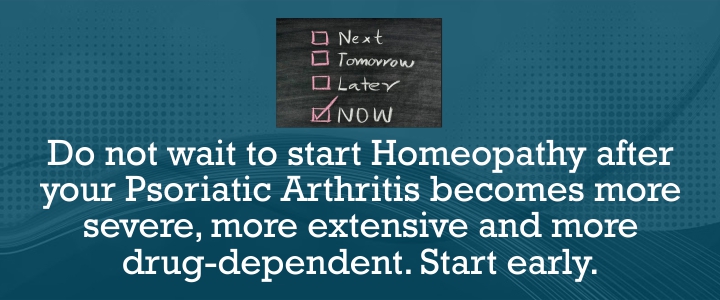
How Does Homeopathy Work For Psoriatic Arthritis?
Homeopathic treatment works efficiently for individuals suffering from Psoriatic Arthritis. Homeopathic remedies help to control the pain, stiffness, and swelling by focusing on the underlying root cause of the problem, providing long-term relief, and reducing the risk of re-occurrence. It's safe, natural, and free of side effects.
Homeopathic treatment works to improve your immunity and strengthen you from within. It is based on the concept of immuno-correction.
Homeopathic constitutional treatment will reinforce the immune system which is vital in the body's defense, assisting in making antibodies and facilitating the recognition and rejection of foreign tissues.
Homeopathic medicines work as powerful anti-inflammatory medicines that help in reducing the symptoms, such as swelling and stiffness, gradually and heal you from within effectively. It is primarily aimed at:
- Controlling the pain, stiffness, swelling, and inflammation.
- Controlling the progression and underlying disease process which is responsible for the cause of the disease.
- Controlling the further spread and promoting the healing of psoriasis lesions.
- Controlling the deformity.
The further progress of the pathology is halted.
One may have to resort to taking NSAIDs as a first step to relieve the pain.
By going for homeopathic treatment, most patients start experiencing positive results 6-8 weeks onwards, though the duration of treatment varies from case to case depending on the extent of the disease.
Homeopathic medicines are not painkillers. They address the disease from the roots and promote healing from within.
The medicines also help in slowing down the progress of the diseases and the development of complications. Medicines also improve mental and physical stress-taking abilities and alter the hereditary predisposition to the disease.
The Duration Of Homeopathic Treatment
Psoriatic Arthritis is a chronic, inflammatory, and progressive disease, and the exact duration of homeopathic treatment for this condition cannot be predicted.
The duration of treatment varies from patient to patient, depending on the following factors:
- The duration of the disease
- The intensity and severity of the symptoms
- The extent of damage to the joints.
- The extent and spread of the disease to other organs
- The patient's age and general vitality
- Genetic tendency
- Conventional Treatments taken so far
Homeopathic Medicines For Psoriatic Arthritis
Commonly prescribed homeopathic medicines for Psoriatic Arthritis are Kali carbonicum, Rhus Toxicodendron, Natrum Muriaticum, Sulphur, Thuja occidentalis, Sepia, Silica, and some more. Besides these homeopathic ingredients, our medicines also contain Dr. Shah's internationally patented, research-based, and highly effective molecules.
However, homeopathic treatment entails the intake of medicines which are decided after an individual case study. As every case calls for a detailed study of the patient, the treatment is tailored only after an ‘in-depth’ evaluation of the individual case.
What Happens In Psoriatic Arthritis? (Pathogenesis)
The precise mechanisms underlying the pathogenesis of psoriatic arthritis which includes genetics, environmental factors, and immune-mediated inflammation, are complex, and the relationship between the disease of the joint and that of other domains is poorly understood. Current evidence suggests that Psoriatic Arthritis occurs in a genetically primed individual in whom stress or entheseal-derived antigens may perturb the immune response, thereby resulting in angiogenesis, T-cell infiltration, and cytokine release. Also, the increased incidence of HLA-B7 is correlated with psoriatic arthritis. Pro-inflammatory cytokines, such as tumor factor-alpha necrosis (TNF-a) and IL-1, IL-6, Il-2, and IL-8 may trigger psoriatic arthritis. The main components are the action of environmental triggers on a genetically and environmentally-friendly host.
Although there are powerful heritability variables, Psoriatic Arthritis is not simply a subset of Psoriasis. Additional HLA and possibly other genes lead to the development of the disease. Tissue participation in Psoriatic Arthritis involves synovium and skin, but MRI and US studies have identified the participation of the enthesis as well as the joint capsule and tenosynovial tissue.
Prevalence Of Psoriatic Arthritis
According to the Annals of Rheumatic Disease, between 6% and 42% of individuals suffering from psoriasis are likely to develop psoriatic arthritis. Psoriatic arthritis generally occurs 5 to 12 years after the onset of psoriasis. Both men and females are similarly likely to develop psoriatic arthritis.
Most people are likely to develop it between 30 and 55 years of age. But, Psoriatic Arthritis can begin at any age and can be diagnosed during childhood as well. In children who develop Psoriatic Arthritis, the most common age of onset is 11 to 12.
Causes Of Psoriatic Arthritis
There is no known cause of Psoriatic Arthritis, but it is known that genes play a major role in the development of this condition. Certain triggers, such as viral infection, injury, or some environmental factors, are responsible for triggering psoriatic arthritis.
About 40% of patients suffering from Psoriatic Arthritis have a close relative with the disease.
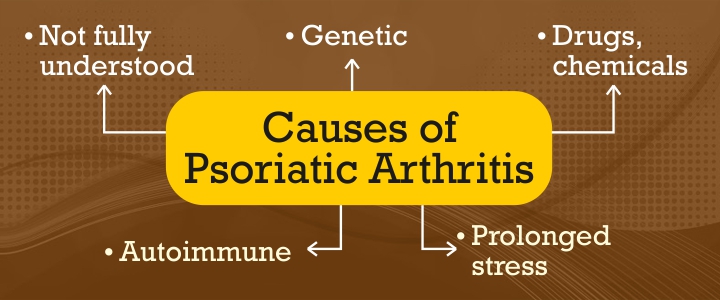
Approximately 40% of patients with psoriatic arthritis have a family history of these autoimmune disorders, such as psoriasis and psoriatic arthritis, in their first relatives. Psoriatic Arthritis is a disease with immunological mediation that has some genetic connections and it could be caused by emotional stress at certain circumstances.
However, not everyone who gets psoriasis will eventually develop psoriatic arthritis. So, there are no proven techniques or ways to tell who will get psoriatic arthritis. However, several theories have been postulated that it stems from a combination of genes and environmental factors.
Psoriatic arthritis, like psoriasis, is an auto-immune disease. Autoimmune diseases are those in which the body's immune system, which is intended to defend the body against viruses, bacteria, and other invaders, is mistakenly responsible for causing or perpetuating the disease. It’s like the body's defense system has turned on against its host.
And, in the case of Psoriatic Arthritis, the body misunderstands the joints and tendons as aliens.
Symptoms Of Psoriatic Arthritis
Psoriatic Arthritis usually develops gradually with mild symptoms, but it can develop quickly and be severe, as each case is different. Early identification, diagnosis, and treatment for psoriatic arthritis are keys to preventing or limiting the extensive joint damage that occurs in later stages of the disease. Some may develop Psoriatic Arthritis in a joint after an injury (which may appear to be a cartilage tear).
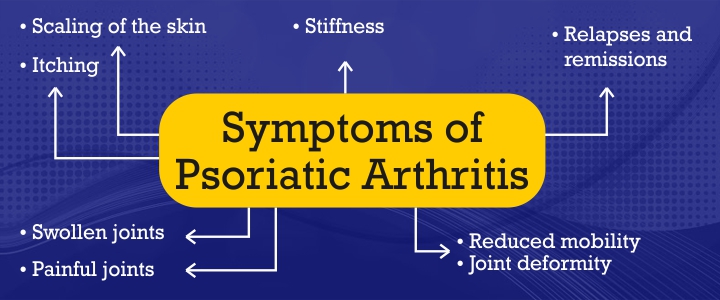
Psoriatic Arthritis can influence any joint in the body. The most common symptoms can include:
- Swollen fingers and toes, that sometimes resemble sausages
- Tenderness, pain, and swelling in one or more joints, and over tendons
- Red scaly skin patches are known as plaques
- Reduced range of motion of the joints
- Morning stiffness
- Lower back pain, upper back pain, and neck pain
- Nail changes, such as pitting or separation from the nail bed, mimicking fungus infections
- Redness and pain of the eye (uveitis)
There is little association between the severity of Psoriasis and Psoriatic Arthritis. Having a severe case of Psoriasis does not necessarily mean you will have a severe case of Psoriatic Arthritis. You could have a few skin lesions but many joints may get affected by arthritis.
Patients suffering from Psoriatic Arthritis may develop problems, such as generalized fatigue, tendonitis, dactylitis (finger pain and swelling), heel pain, and reduced joint mobility. While there are five different types of psoriatic arthritis, the most common type affects the joints asymmetrically.
While Psoriatic Arthritis can certainly affect an individual’s quality of life, the symptoms of the disease can be managed effectively. Paying proper attention to and addressing the signs of the disease as quickly as they appear is essential in attaining positive outcomes.
Types Of Psoriatic Arthritis
There are five distinct types of PsA:
- Symmetric: This type of psoriatic arthritis affects the same joints in multiple matching pairs bilaterally. It can be disabling, resulting in varying degrees of progressive joint destruction and a loss of function.
- Oligoarticular (Asymmetric): This type of psoriatic arthritis affects only a few joints but not match pairs on opposite sides of the body. It is often a milder form of the disease.
- Distal Interphalangeal Predominant: This type of psoriatic arthritis primarily affects the joints closest to the toenails and fingernails. It is sometimes confused with osteoarthritis.
- Psoriatic Spondylitis: This type of psoriatic arthritis affects the spine anywhere from the neck to the lower back.
- Arthritis Mutilans: This type of psoriatic arthritis is a rare but severe, destructive form of the disease. It may lead to a loss of joint function.
Diagnosis Of Psoriatic Arthritis
Since there are no definitive tests for diagnosing Psoriatic Arthritis, diagnosing it can be tricky at times, mainly because it shares similar symptoms with other arthritic conditions, such as osteoarthritis, rheumatoid arthritis, and gout. Because of its similar symptoms, misdiagnosis can often be an issue. Early diagnosis, however, is essential because joint damage can be better prevented in the first few months after the signs develop.

A comprehensive medical history and physical examination can be used for diagnosing Psoriatic arthritis, along with blood tests, X-rays, and MRI scans of the affected joints.
Psoriatic arthritis can be diagnosed more easily if the psoriasis is active or present along with the swollen fingers or toes when the patient is examined.
Psoriatic arthritis' distinctive feature is an asymmetric pattern of digit involvements. Interphalangeal joint participation is associated with the digit sausage appearance of the digits (dactylitis). The inflamed articulations are swollen and have a purplish-red discoloration. Also, a firm diagnosis of Psoriatic arthritis can generally be made if the participation of the nail is evident.
Standard X-rays generally do not show indications of Psoriatic arthritis in the initial/early phases of the disease and may not help to diagnose it.
However, in later stages, Psoriatic Arthritis may be distinguished from other rheumatic diseases by distinctive modifications such as ‘pencil-in-cup’ phenomenon, in which the end of a bone gets whittled down, eroding into a sharp point where it enters a joint. Changes in the peripheral articulations and spine can also support the diagnosis of Psoriatic Arthritis, in later stages of the disease.
Auxiliary Line Of Treatment For Psoriatic Arthritis
For patients with psoriatic arthritis, following a healthy diet can greatly help with disease management. A treatment regimen that involves medication along with diet, exercise, physical therapy, good posture practices, and other options, such as hot/cold fomentation, helps to relax the muscles and reduce joint pain.

Exercise is essential for preserving strength and maintaining a range of motion in patients with PsA. Isometric exercises, which contract muscles without joint motion, may help avoid damage to the inflamed joints. Physical and occupational therapy can assist the patients in improving the function of arthritic joints. But, these therapies need to be started after consulting your physician to determine which of these treatments is most appropriate for your condition.
Diet to follow
Since Psoriatic Arthritis is an inflammatory condition, foods with anti-inflammatory and antioxidant properties are beneficial for patients suffering from this disease.
Foods, such as Avocado, Leafy greens, (including collards, spinach, kale, Swiss chard, and beet greens), Fish (such as salmon, etc.), Green tea, etc. are rich in antioxidants and anti-inflammatory properties and must be a part of your psoriatic arthritis diet.
Following a diet with adequate amounts of calcium and vitamin D will help reduce the risk of osteoporosis and strengthen the musculoskeletal system.
Foods known to cause inflammation, such as processed meats (e.g. hot dogs, sausages, & bacon), saturated fats, trans-fats, sugar and sugar products, alcohol, refined flours products, processed foods (e.g. packaged cakes, cookies, and other similar snacks), etc. should be avoided if you are suffering from psoriatic arthritis as they act as triggers causing symptoms to flare-up.
These foods also are the key factors in weight gain and obesity. The stress on your joints increases as the weight increases, so managing your weight is beneficial for managing psoriatic arthritis.
Also, ask your doctor about the medications that you taking and how it affects your body. As some medications cause the retention of sodium in the patient, while others cause potassium loss. For example, Methotrexate can lower folic acid levels, causing a variety of adverse symptoms that can be offset by taking additional supplements.

Conventional Treatment For Psoriatic Arthritis
Currently, there is no known cure for this degenerative condition. Conventionally, treatments for psoriatic arthritis range from most commonly used oral medications, such as NSAIDs, DMARDs, sulfasalazine (Azulfidine), etc. that help to reduce the inflammation and swelling, to biological drugs (such as TNF inhibitors) that are injected or infused and target specific parts of the immune system to manage the pain, achieving symptomatic relief and slow down the joint damage.
In specific cases with end-stage joint destruction, reconstructive surgery is needed.
Related Disease:
- Rheumatoid arthritis
- Reactive arthritis
- Spondylitis
- Systemic Lupus Erthematosus
- Ankylosing Spondylitis